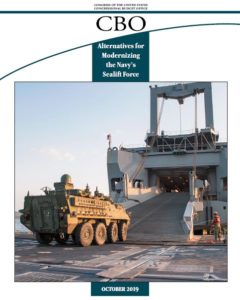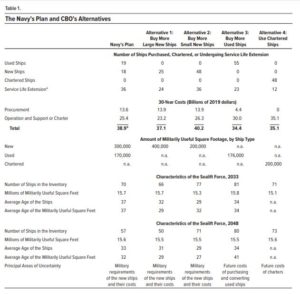A new Congressional Budget Office (CBO) report says the Navy’s estimate for the cost of potential new sealift vessels is about double what standard practice expects.
The report released last week, Alternatives For Modernizing the Navy’s Sealift Force, analyzed the Navy’s March 2018 plan to modernize the sealift force over the next 30 years. It compared the Navy’s estimate to four alternative plans.

The Navy’s plan consists of modernizing the current sealift force of 75 ships by extending the service lift of 36 current ships to last another five to 10 years, buying 26 used ships in the 2020s, then buying 18 new ships starting in 2025. The Navy assumes the ships would be smaller than the current Bob Hope and Watson-class vessels the Navy bought in the 1990s.
CBO underscored the Navy’s sealift plan and the annual 30-year shipbuilding plan did not cover cost estimates for buying ship. But a separate business case analysis sent to Congress had the service estimate the 18 new ships as costing $20.5 billion in 2018 dollars. The Navy said the 26 used ships would cost between $1.8 billion to $4.3 billion.
The report noted the Navy estimates the 18 new sealift ships as costing about $1.14 billion to procure in 2018 dollars each. However, CBO estimates that when using standard practices the average cost for the Navy’s new sealift ship “would be about half of the service’s estimate.”
GAO said the discrepancy is because “the Navy’s business case analysis departed from standard practices” in several ways, the report said.
The $1.14 billion cost was based on construction costs of the lead ship of the Watson-class, bought in 1993, but converted into FY 2023 dollars, then adding the costs of design, a new electronics system, and program support.
While those steps are typical for costing out a new class lead ship, the Navy then redesignated the 2023 dollars as 2018 dollars and kept lead ship costs constant for the follow-on vessels.
“The Navy’s business case analysis departed from standard practice, however, in using the cost of a lead ship as the average cost for all 18 ships. Cost estimates typically charge design and program support costs to the lead ship and exclude them from the costs of subsequent ships,” the report said.
In contrast, CBO said a standard cost estimate would adjust the cost of later ships down to reflect learning as more ships are built.
Moreover, CBO said the Navy’s report said the new ships would be smaller than the Watson-class, but the service did not adjust the price down to cover changes with a smaller ship. Thus, under standard cost-estimating practices, CBO said the Navy’s number is about double the expected cost estimate.
Because of this discrepancy and the Navy’s lack of estimates for operation ad support costs, the CBO “set aside the Navy’s estimates in the business case analysis.” It instead made its own estimates of how much the Navy’s plan will cost when compared to its alternatives.

The CBO estimated the Navy’s current plan will cost about $38.9 billion: $13.6 billion in procurement and $25.4 billion in operations and support or charter. This will also result in 70 ships in the sealift force at an average age of 37 years by 2023. By 2048 that would go down to 57 ships at an average age of 33 years.
CBO’s alternative plans would be for the Navy to buy only new big ships beyond what Congress has authorized, buy new smaller ships, only buy used ships instead, or gradually focus on contracting with private shipping companies to charter vessels for sealift.
Under the CBO alternatives, three of the four would result in more sealift vessels than the Navy’s plans by 2048 while they all have a similar amount of militarily useful square footage. However, that square footage varies significantly between 2023 and the late 2040s.
The Defense Department says it wants to maintain 15.3 million square feet of cargo space on sealift ships to transport military equipment like tanks, artillery, and other armed vehicles.